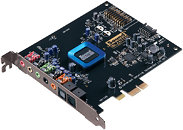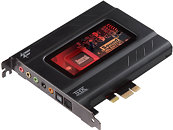Friday, September 2nd 2011

Creative Rolls Out Sound Blaster SoundCore 3D 'Quad-Core' PCIe Sound Cards
Alongside the Recon3D external audio device for PC, Mac, Xbox 360 and Playstation 3, Creative announced its latest line of PCI-Express sound cards. It's curtains for the X-Fi generation of sound cards that led Creative's pack through the second half of the last decade. Creative's newest sound card technology is called Sound Core3D. Unlike with X-Fi which continued the tradition of high-performance native (hardware) audio processing by making use of RISC processors on the card such as the CA20K series, with Sound Core3D "quad-core", the focus finally shifted to the set of DSPs (digital signal processors).
The "quad-core" moniker doesn't refer to there being four processing cores on the sound card, but a set of four DSPs, not necessarily hardware-accelerated, that work to give out the best audio. Two main DSP sets include Creative CrystalVoice and THX TruStudio Pro. THX TruStudio Pro is a DSP set that we're familiar with, some modern sound cards feature it, some motherboard vendors even pack it with their onboard HD audio solutions. THX TruStudio Pro provides THX TruStudio Pro Crystalizer, which works to improve clarity of lossy compressed audio, TruStudio Pro Surround creates a virtual 360 degree surround space that is touted to be better than the countless earlier attempts by various companies, at virtual surround. Smart Volume is a volume stabilizer that keeps in check abrupt volume spikes in games. Dialog Plus controls the mid frequencies to ensure the clearest voice dialog in games (cut-scenes or multiplayer voice chat). Lastly, Pro Bass is a bass compensation feature that works to restore lossy bass.The CrystalVoice DSP is another DSP that improves in-game voice chatter. Acoustic Echo Cancellation eliminates echos and talkback. Noise Reduction works to suppress background noise, sending through only the player's voice. Smart Volume stabilizes volume. FX allows users to morph their voice to remain anonymous.
Microsoft Windows NT 6 kernel, used in operating systems since Windows Vista and Server 2008, saw a relocation of the audio stack, that effectively made hardware audio processing useless, because there's no direct access to hardware using DirectSound. There still is the third-party OpenAL API, but it is greatly limited and doesn't keep up with the latest sound resolutions. For Creative to stay competitive in the sound card industry, it has to do what its younger competitors such as ASUS, Auzentech (to an extant), and HT Omega realized long back, which is focusing on high signal-to-noise ratio (sound fidelity), and DSPs. Today's system processors by Intel and AMD are fast enough to process several DSP layers without impacting on system performance.
Creative's new sound cards include the Sound Blaster Sound Core3D (base model), Sound Blaster Recon3D Fatal1ty Professional and Sound Blaster Recon3D Fatal1ty Champion. The SB Core3D is the base model, its PCB doesn't have any fancy EMI shield. It uses a simple PCI-Express audio processor that does away with most of the RISC processor components of the CA20K series audio processors. There's a rounded-square fancy-looking object in the middle that screams "SoundCore 3D". I suspect it's an EMI shield for the DAC under it. It features common HDA front-panel output, Fatal1ty Champion front-panel IO capability, and a common-looking set of 7.1 channel analog jacks next to TOSLINK digital input and output connectors.
The Recon3D Fatal1ty Professional ups the ante with a groovy looking EMI shield for the entire PCB, a red LED lighting, and a polycarbonate window. This card comes with a beam microphone that helps with the CrystalVoice technology. The Recon3D Fatal1ty Champion takes it a notch further with a front panel that fits into the 5.25"/3.5" exposed drive-bay, and provides some connectivity such as headphone out, volume control, and DSP control.
The "quad-core" moniker doesn't refer to there being four processing cores on the sound card, but a set of four DSPs, not necessarily hardware-accelerated, that work to give out the best audio. Two main DSP sets include Creative CrystalVoice and THX TruStudio Pro. THX TruStudio Pro is a DSP set that we're familiar with, some modern sound cards feature it, some motherboard vendors even pack it with their onboard HD audio solutions. THX TruStudio Pro provides THX TruStudio Pro Crystalizer, which works to improve clarity of lossy compressed audio, TruStudio Pro Surround creates a virtual 360 degree surround space that is touted to be better than the countless earlier attempts by various companies, at virtual surround. Smart Volume is a volume stabilizer that keeps in check abrupt volume spikes in games. Dialog Plus controls the mid frequencies to ensure the clearest voice dialog in games (cut-scenes or multiplayer voice chat). Lastly, Pro Bass is a bass compensation feature that works to restore lossy bass.The CrystalVoice DSP is another DSP that improves in-game voice chatter. Acoustic Echo Cancellation eliminates echos and talkback. Noise Reduction works to suppress background noise, sending through only the player's voice. Smart Volume stabilizes volume. FX allows users to morph their voice to remain anonymous.
Microsoft Windows NT 6 kernel, used in operating systems since Windows Vista and Server 2008, saw a relocation of the audio stack, that effectively made hardware audio processing useless, because there's no direct access to hardware using DirectSound. There still is the third-party OpenAL API, but it is greatly limited and doesn't keep up with the latest sound resolutions. For Creative to stay competitive in the sound card industry, it has to do what its younger competitors such as ASUS, Auzentech (to an extant), and HT Omega realized long back, which is focusing on high signal-to-noise ratio (sound fidelity), and DSPs. Today's system processors by Intel and AMD are fast enough to process several DSP layers without impacting on system performance.
Creative's new sound cards include the Sound Blaster Sound Core3D (base model), Sound Blaster Recon3D Fatal1ty Professional and Sound Blaster Recon3D Fatal1ty Champion. The SB Core3D is the base model, its PCB doesn't have any fancy EMI shield. It uses a simple PCI-Express audio processor that does away with most of the RISC processor components of the CA20K series audio processors. There's a rounded-square fancy-looking object in the middle that screams "SoundCore 3D". I suspect it's an EMI shield for the DAC under it. It features common HDA front-panel output, Fatal1ty Champion front-panel IO capability, and a common-looking set of 7.1 channel analog jacks next to TOSLINK digital input and output connectors.
The Recon3D Fatal1ty Professional ups the ante with a groovy looking EMI shield for the entire PCB, a red LED lighting, and a polycarbonate window. This card comes with a beam microphone that helps with the CrystalVoice technology. The Recon3D Fatal1ty Champion takes it a notch further with a front panel that fits into the 5.25"/3.5" exposed drive-bay, and provides some connectivity such as headphone out, volume control, and DSP control.


69 Comments on Creative Rolls Out Sound Blaster SoundCore 3D 'Quad-Core' PCIe Sound Cards
"People know what they do; frequently they know why they do what they do; but what they don't know is what what they do does."
— Michel Foucault
Just Get then the Titanium HD. It is also not that bad... And the name is quite normal also :D
youre paying that high price for what??? real EAX support??
www.ziilabs.com/news/releases/pr20110504.aspx
they ditched the x-fi name, possibly to get away from their mixed reputation.
MOD: oh well, some new threads to clean up... lol wut, creative? well fuck that, man. :p
Creative had/has some great hardware, but software wise they are really late. And I hate that all the new drivers they release are beta. What are we? Testers ??
1 slot saved, still I still would like to see them before a I pass judgement on them because creative has a "funny" history with what they believe is new and whats not, they're good at wording things to sound a certain way just for them to be crap.
;)
oh, btw I haven't had any software problems with my Titanium HD.
I also didn't have any problems with my XFi platinum b4 either(Daniel K FTW).
now, these DSP boards looks like shit.
can this soundcard support winxp???
My experience with Creative was rather simple . . .
I had an onboard solution which ingame gave me a simular quality output with my previous sound card (Some dodgy Yamaha card), then i purchased an XFi Extreme Music/Audio.
The result was obvious to me ingame. Obviously it was obvious to everyone that i played with. The XFi Sound Card with its features actually being utilized ingame placed me at an advantage beyond other players to the point where i averaged 100 kills for every death in First Person Shooter games. It got to the point where i was forced to record myself and upload the footage to shut up the accusations of wall-hacking.
As dodgy as the driver support was from Creative and as bad as most people make their products out to be, it must also be realized that the Xonar and other comparable products in this price range were not released at the same time.
The Creative card i had did the job to a supurb standard, long before anyone else had anything else to offer me. The only issue i have with my Sound Card is that in combination with Windows 7 64-bit i have lost half the features and quality but this is not a complaint, seeing as when i purchased the product, Vista was still on the drawing board and the card designed for XP.